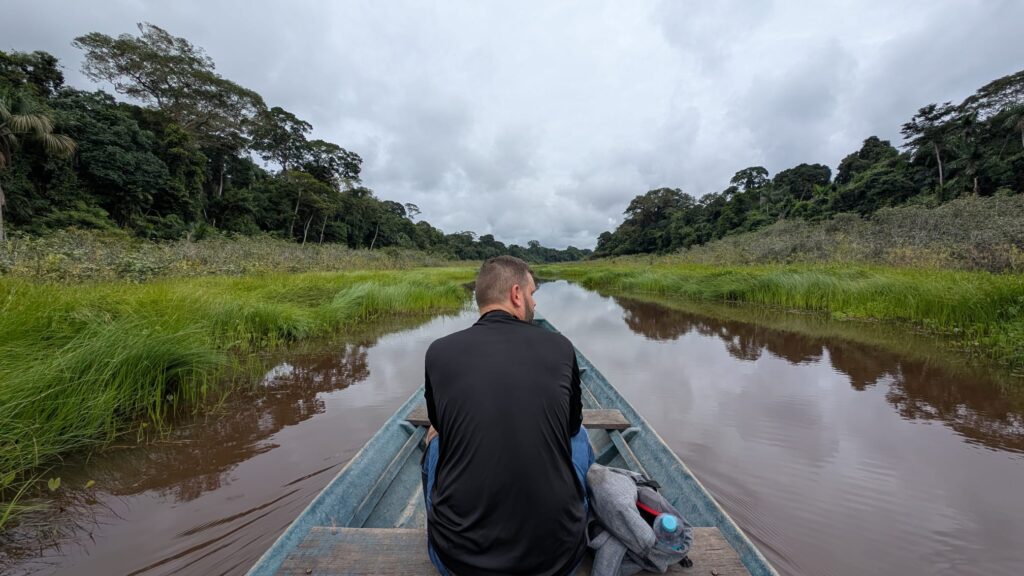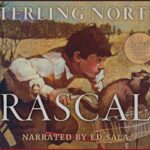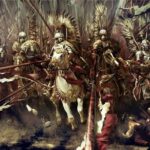Literature
Reading Gerald Durrell in the Amazon jungle
Despite my lifelong obsession with wildlife, I only discovered the great naturalist writer Gerald Durrell several years ago. I was captured immediately. His exploits in jungles, deserts, and plains around the world and his magnificent renderings of man and beast make Durrell to wild animals what James Herriot is for domestic creatures, with the same potent alloy of heartwarming hilarity. His stories about South America fascinated me, and so on my first trip into the Amazon, I took him with me.
This year marks the centenary of Gerald Durrell. Jersey Zoo—his great legacy—kicked off a series of events in January, when he would have turned 100. Durrell, who died at age 70 in 1995, obstinately insisted that he only wrote to pay the bills for his zoo, which hosts some of the first and most successful endangered animal breeding programs on earth. Durrell is personally credited with saving at least a half dozen species from extinction; the impact of his books on conservation efforts has also been incalculable.
Durrell spent his youth on the Greek island of Corfu. His heavily fictionalized trilogy of that time, starting with My Family and Other Animals (1956), made him famous. Durrell began working as a student zookeeper at Whipsnade Park in 1945, and in 1947 made his first animal-collecting expedition to the British Cameroons. He told that story in The Overloaded Ark, published in 1953. Over the ensuing years, Durrell headed off on similar adventure-laden voyages to Cameroon, British Guina, Argentina, and Paraguay, writing books about each expedition.
In 1959, after nearly a decade of selling to other zoos, Durrell founded his own on the island of Jersey, stashing his first animals at the home of his long-suffering sister Margaret’s boarding house in Bournemouth. He established a charitable trust dedicated to conservation in 1963, and his literary fame soon brought high profile patrons such as Princess Anne as well as a slew of documentary deals with the BBC. He wrote over thirty books about his expeditions, the last being a travel diary of his trip behind the Iron Curtain to track the wildlife of the Soviet Union. (His brother Lawrence, known to Gerald’s readers as “Larry,” was the famous novelist who John Steinbeck beat out for the Nobel Prize in 1962.)
To reach the jungle, we flew from Lima to the Puerto Maldonado, the gateway to the Amazon, over cloud-filled valleys and mountains dotted with the gleaming roofs of tiny villages and twisting mountain pathways sparkling in the sun like skeins of silver.
***
One does not simply walk into the Peruvian Amazon. We took a boat 55 kilometers downriver, skimming over a brown highway of water twisting through rainforest rising on either side. Cayman and capybara could occasionally be seen on the banks or in the river (we almost ran over three swimming capybaras on the boat ride back) as well as yellow-spotted turtles basking, hunting herons, and throngs of other creatures.
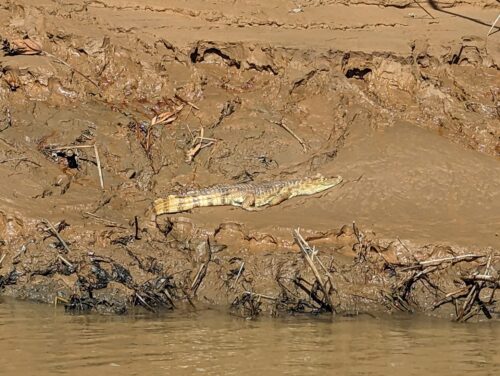
Durrell’s descriptions of insects feasting on his flesh as he tramped through the jungle are hilarious. The actual experience is not. Even when layered with clothing and glazed with every available bug spray, tiny insects successfully left deceptively miniscule bites that grew into itching welts that lasted weeks. When the sweat greased away the bug spray, they attacked in swarms. The Spaniards trekked this jungle in 90% humidity, 70% insects, and full-body armour to conquer the Incan empire.
After reading hundreds of pages of Durrell exploits in which he thrust his arms into dark holes, splashed fearlessly through swamps, streams, and ponds, and blundered about in the rainforest with lassos and nets and canvas bags, I imagined it might be possible to do a couple of hikes into the jungle on my own. But if our guide’s reaction to my suggestion was any indication, Durrell should have been dead almost immediately.
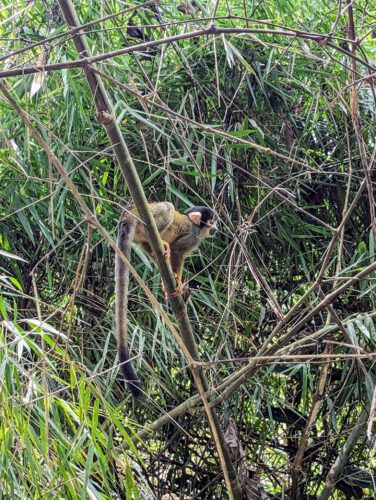
“We do not advise it,” he stated at me with great gravity. He paused thoughtfully for a moment, as if envisioning me being savaged by a jaguar, then nodded again emphatically. “We do not advise it.” I decided to limit my activities between supervised treks to viewing the agoutis, lizards, and squirrel monkeys from the safety of the compound boardwalk and reading Durrell’s The New Noah beneath mosquito netting, a few dozen yards from the edge of the forest.
The best place to view animals safely, our guide insisted, was “on the reever.” The reever, he assured us, was safe.
***
We left for the clay lick cliffs by boat at 3:30 AM. Heat lightning crackled above us, illuminating the clouds like celestial Japanese lanterns while fireflies sparkled in the forest along the river. The Amazon is incredible by day. By night, it is magic. As I scanned a powerful flashlight along the river, the beam caught the fiery red eyes of caymans glowing on the surface and eyes along the bank pausing for a split second before vanishing into the underbrush like fireflies winking out. We arrived at the cliffs, where animals regularly come to consume mineral-rich clay, just before dawn.
The birds arrived with the sun. There were hundreds of them: scarlet macaws, blue and yellow macaws, yellow crowned parakeets, Amazon parrots, landing in the trees above the clay cliffs, calling raucously to each other, encrusting the tree branches like swaying jewels, and peering anxiously into the underbrush for eagles or ocelots. No predators materialized. The only carnivorous bird in sight was a small burrowing owl on a log by the riverbank, gazing about with an exceedingly judgmental look on his face.
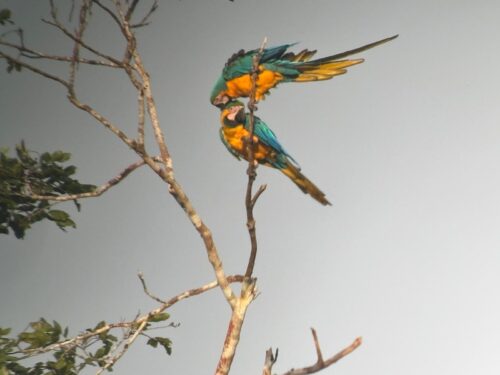
Over and over the macaws ascended, circled, and returned to the trees, talking noisily to their mates (macaws are monogamous for life), suspicious that unseen predators might appear if they landed. The smaller parrots abandoned caution first, descending onto the cliffs to worry at the clay. The macaws, however, took their time, even when their smaller cousins were not immediately eaten. When the macaws finally came to the cliffs, they clung just long enough to carve a mouthful of clay before lifting off into the leaves once again.
As the sun climbed, the macaws left in pairs, the parakeets in flocks, the sound of their conversation receding over the treetops. Within an hour, all that remained was the sound of the water and the trees, and it felt like the silence after great music ends.
***
“At night the jungle was a place of mystery…filled with a thousand rustlings and whisperings, as though the trees and the undergrowth were alive with secret life,” Durrell wrote of his first expedition into the South American rainforest. An hour into our first nighttime trek, Durrell’s descriptions of capturing wildlife in the rainforest by night seemed miraculous. Enveloped in darkness, the sounds closed in. Even after our eyes adjusted, and even with a high-beam flashlight, it was nearly impossible to discern where they came from. A frog playing what sounded like a bassoon inches away from us was utterly undetectable by sight.
The wildlife we did see was due to our guide’s almost supernatural ability to pick out creatures in a maze of darkened trees and vines. At one point he suddenly raised his hand to stop us and stabbed his flashlight into the forest; a mouse opossum quivered in the beam, a dozen yards into the jungle. These entrancing, slender-faced tree-dwellers look nothing like the vaguely evil-looking, rat-like marsupials of North America. They bear far more resemblance to a harvest mouse, and are only slightly bigger.
Durrell obtained a mouse opossum on an animal collecting trip to South America in 1958. “Maxie, the mouse opossum, was a creature so fragile and delicate that you felt a puff of wind would blow him away,” he wrote. “He had a long, tapering snout, enormous liquid eyes that stared at you with a mixture of fear and indignation, and a silky grey coat. He would sit in his cage, his tiny pink hands clasped together like a child saying its prayers, and scold me in a series of shrill squeaks if I so much as moved too quickly.”
Some of the spiders were bigger. A tarantula that could have covered my entire hand awaited us just inside the jungle, crouching near a den awaiting prey. Our guide, who was apparently a PR agent for the arachnid family, informed us that he was not dangerous, because he was blind. Nobody seemed inclined to test this theory. Another grotesque, furry black tarantula was easily the size of a dinner plate. The Goliath birdeater, a species of tarantula, can reach a leg span of up to 12 inches and a body length of 5 inches, and is the world’s largest spider. This particular giant was sitting on a log in the twilight. The guide pointed it out to us with great cheerfulness while we hastily crowded to the other side of the path.
(Upon reading this section, my wife Charmaine offered an emphatic correction: “I almost walked into it. It reached out and tickled my leg as if to say: I can get you at any time.”)
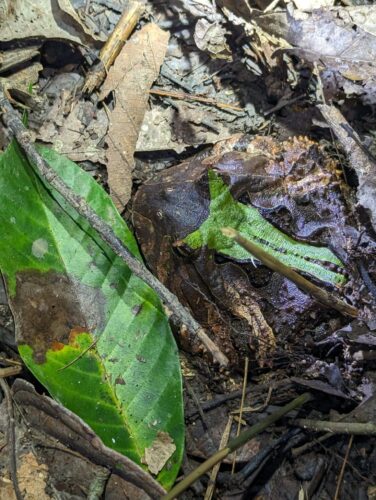
At one point, our guide discovered an enormous horned frog buried in the path, only his eyes and the bright green stripe on his back protruding above the soil. These huge amphibians grow up to 20 centimeters long and eat fish, lizards, and mice. We were clearly too large for him, because he only glared at us—although, as Durrell wrote in The Whispering Land, these frogs are willing to attack humans if sufficiently provoked:
One of the most alarming creatures I met during this trip was a horned frog, a creature with a cavernous mouth and jaws like a bulldog. I was foolish enough to try and pick one up with my bare hands, and it fastened onto my finger with a grip that made me yelp. It took two of us to prise the brute off, and the wound it left throbbed painfully for a fortnight afterwards. I treated that particular species with great respect after that, for I had no desire to lose a finger to its enthusiastic bite.
The most alarming sound came from the bamboo rat. We heard him booming constantly through trees; Durrell described the sound perfectly as “halfway between a sneeze and a bark, a short, shrill sound that seemed to explode out of the undergrowth.” I could not locate the large rat no matter how hard I searched. Even though bamboo rats are nocturnal, we came across one the following afternoon slogging through a swamp. When we spotted each other, he instantly hunched on his branch with great mortification, like someone caught singing in the shower when he thought nobody was home. He remained frozen in place until we had sloshed past him.
***
In an oxbow lake a half-hour hike through the jungle from the boat, we met the giant river otters. These endangered creatures are nothing like their much smaller North American cousins; giant river otters are the Amazon’s apex predator, reaching up to six feet long and weighing between 60 and 70 pounds. Not even jaguars, caimans, or anacondas trump their dominance. The largest anaconda discovered in the Amazon measured 26 feet long, but these legendary serpents can be attacked by giant river otters working together as a family, coordinating to attack the snake’s head and undersides. (We didn’t see an anaconda, but massive, foot-wide swathes through the grassy swamps indicated their presence.)
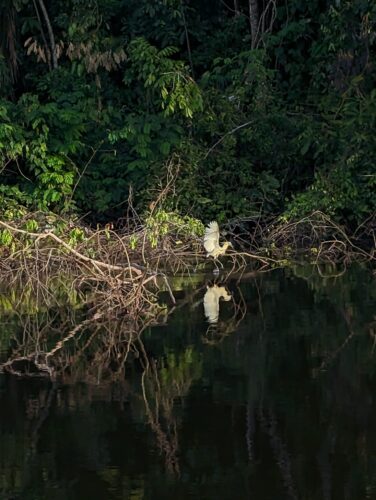
We poled our barge-like raft across the glassy lake, the sun gleaming on the surface and mirroring the jungle. A giant white egret winged from log to tree, followed by his reflection. We heard a hoarse, huffing sound from the bushes along the bank. Our guide huffed back. There was an immediate, frantic panting in response, and a moment later, a strange, wild-eyed head was thrust into view. The brown-and-yellow hoatzin, featuring a chaotic Mohican tuft of feathers atop his head, glanced nervously about, looking like a strung-out rock star who has just been called upon to perform.
The hoatzin’s eyes are set in a bright patch of blue skin, but they have few natural predators because their diet of leaves ferments in their stomach, giving off an odor that has earned them the nickname “stinkbird” and ensures that predators usually give them a wide berth. Their natural enemies assume, based on smell, that the hoatzin is either rotten or poisonous. (This assumption usually works well for rock stars, also.) It was quite excellent to huff at the bushes and immediately hear what sounded like the panting of a heavy smoker attempting to flee great danger in response, followed by one large, worried eye appearing in the foliage.
After an hour on the water, the jungle around us came alive. Golden-brown howler monkeys, some with babies clutching tightly to their bellies, bellowed at each other and occasionally leapt from tree to tree. Chattering troops of capuchin monkeys shook the leaves. The otters finally materialized near sunset, after the guide gave a coughing bark as we poled along the bank. Three enormous heads surfaced: the largest coughed back, showing a set of large, sharp fangs. “I thought they would be cute,” an American girl commented in disappointment. When the guide coughed, the red-eyed otters would breach, bare their teeth, and bark in return.

“Suddenly, round a bend in the river, came a family of giant otters, locally called water dogs,” Durrell wrote of his own sighting. “There were five of them, swimming rapidly downstream, their sleek heads cutting the water, leaving a V-shaped ripple behind them. They were enormous creatures, nearly six feet long, with glossy, chocolate-brown fur and broad, flattened tails. As they swam, they uttered a series of high-pitched, barking cries, like excited puppies, and every now and then one would rear up in the water, standing almost upright, to peer ahead.” Durrell never successfully captured any of them.
Our otters played and fished until it was almost dark, and then sank with scarcely a ripple, and were gone.
***
It is easy to see how Durrell acquired so much material for his books. It is more difficult to imagine how he managed to capture so much wildlife. Despite hunting for a tapir, we only came across fresh tracks. The Amazon red squirrels, coatis, and six-lined racerunner lizards were incredibly fast. Only the hummingbirds—there are 124 magnificent species in Peru—warm up to humans, with one almost incandescent bird alighting on Charmaine’s hand as she held out honey water in a mountainside garden swarming with them.
I prefer Durell’s own accounts to his authorized biography by Douglas Botting, and the posthumous Myself and Other Animals, a collection of previously unpublished writings released for his centenary late last year. Privately—and these convictions occasionally seep into his writing in the final pages of his books—Durrell was often deeply depressed about the impact of civilization on nature and maintained an unhealthy contempt for “human animals.” These sentiments are understandable, but Durrell’s materialism naturally produced only despair.
But for those who believe in a Creator, Durrell’s descriptions are a riotous revelation of divine artistry. It is true that in a fallen world, there is as much suffering and misery in the wild as there is in civilization; it is also true that the picture in the broken mirror still reveals beauty beyond imagining. On our last evening in the Amazon, we climbed a steel tower high above the canopy to watch the sun set over the jungle. As the sun sank to the treetops and melted from yellow to fiery orange, the birds began lifting off from the trees to fly home for the night, emitting their wild hymns to the sky as they went.


